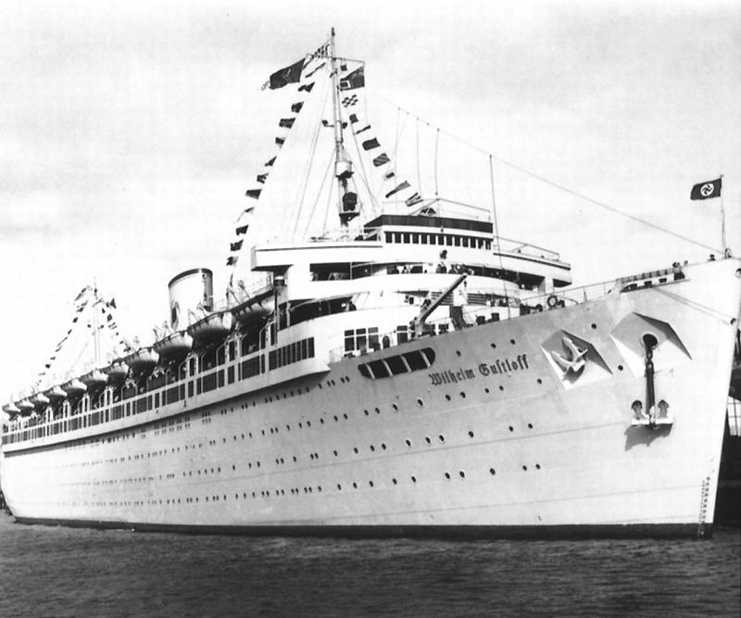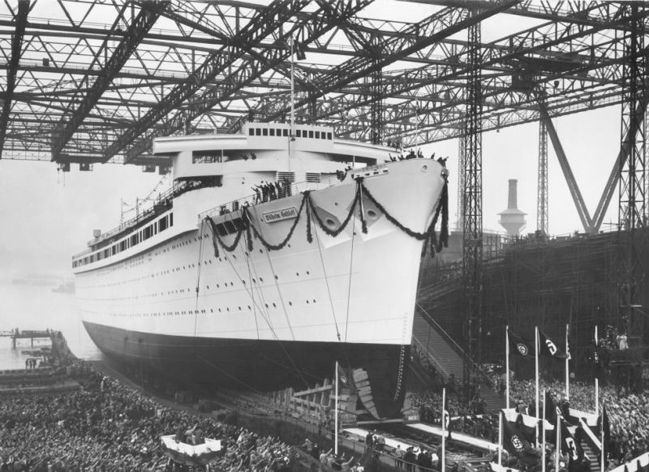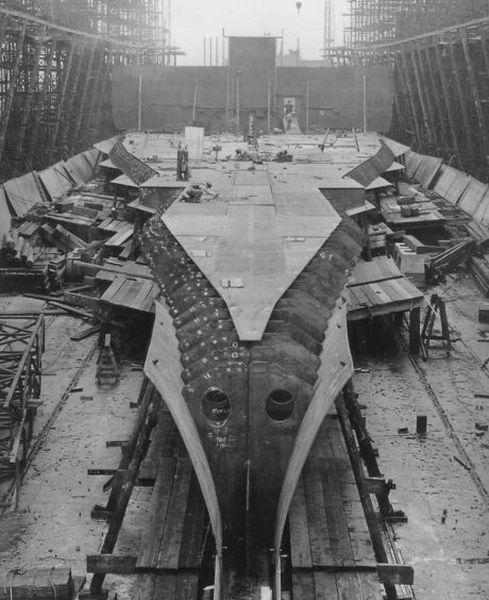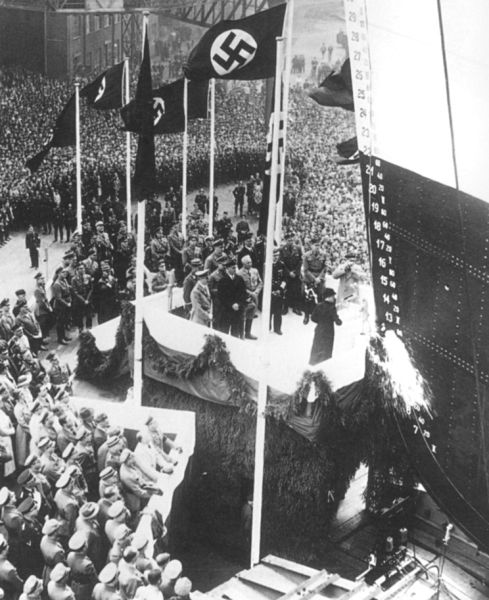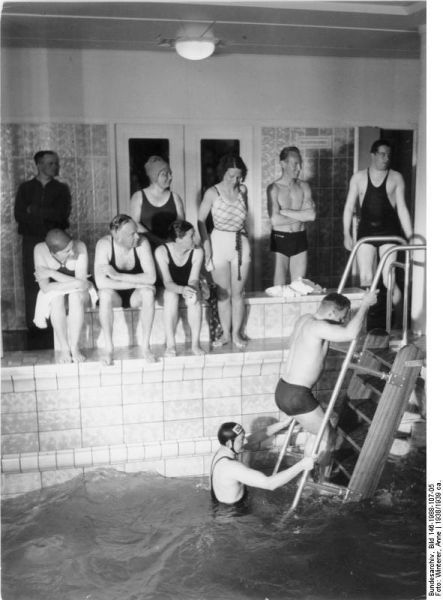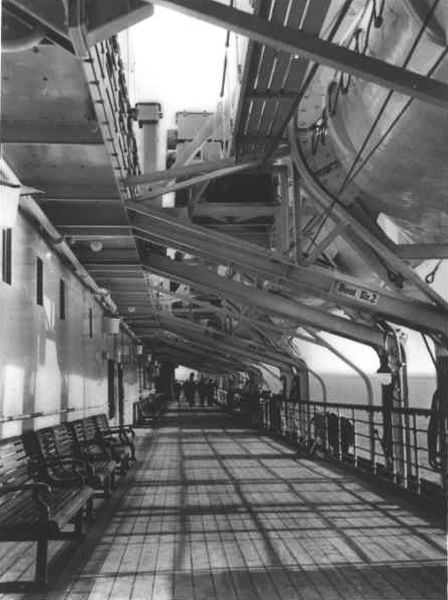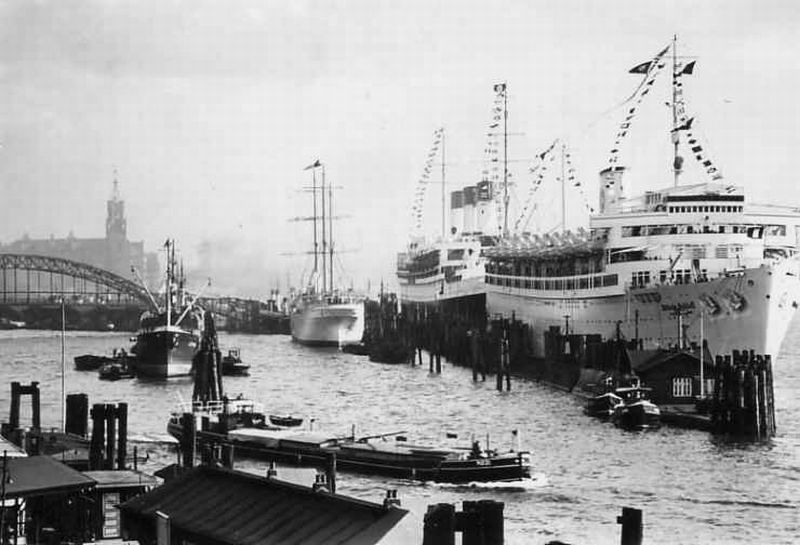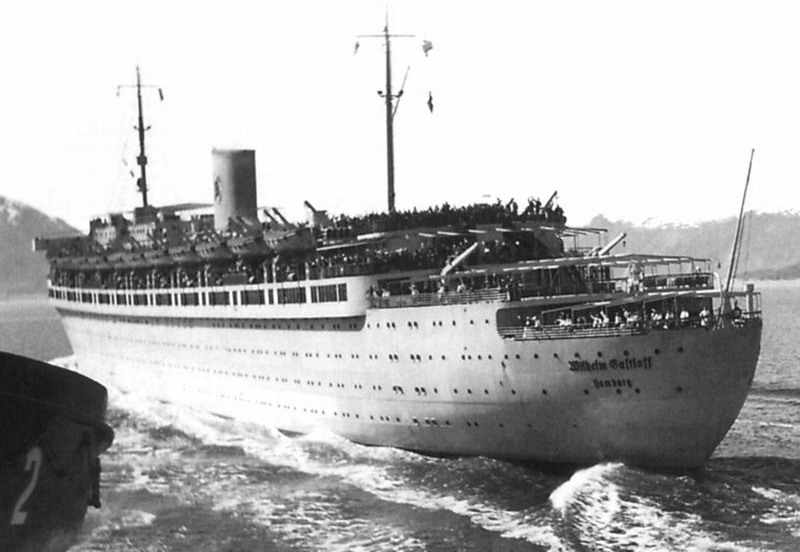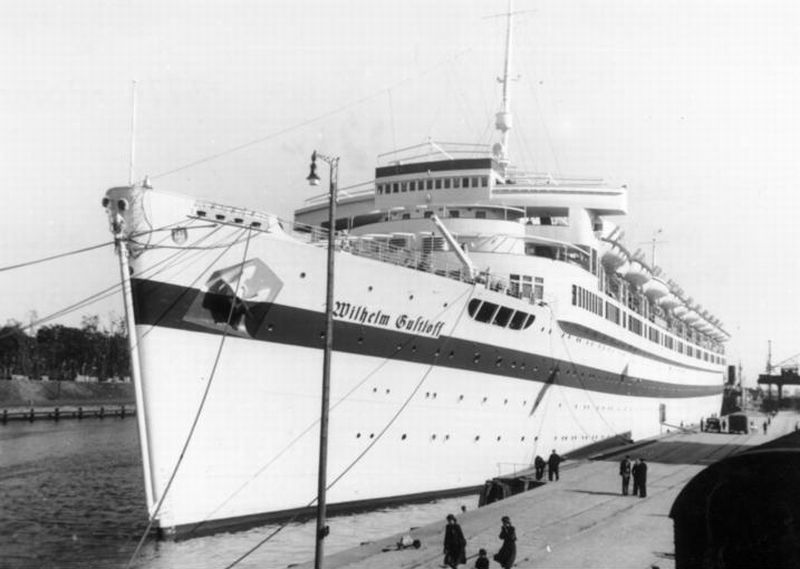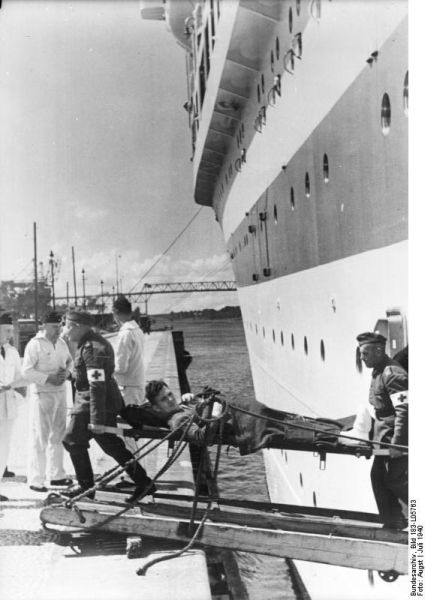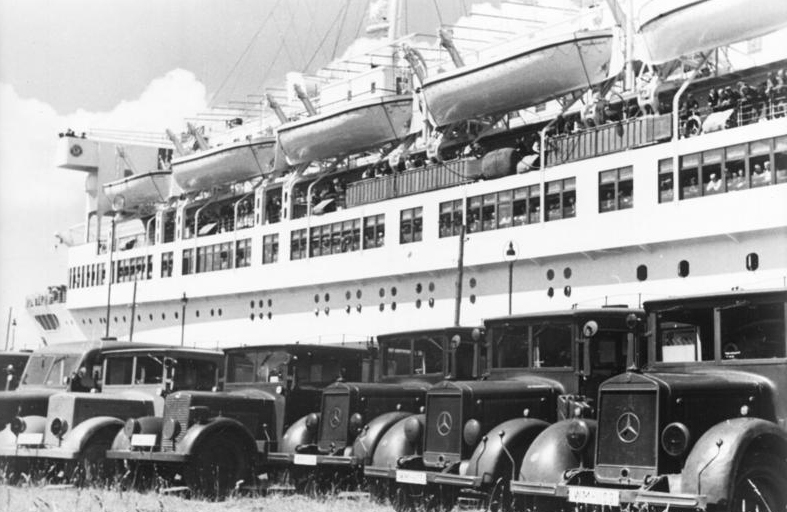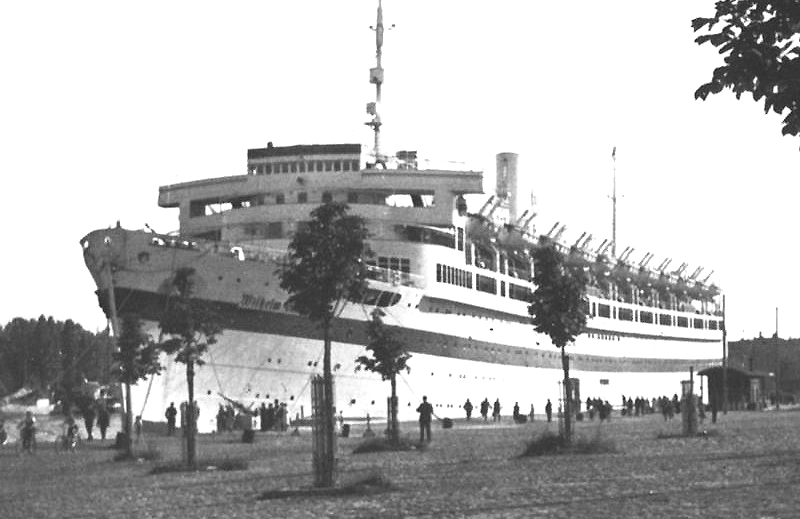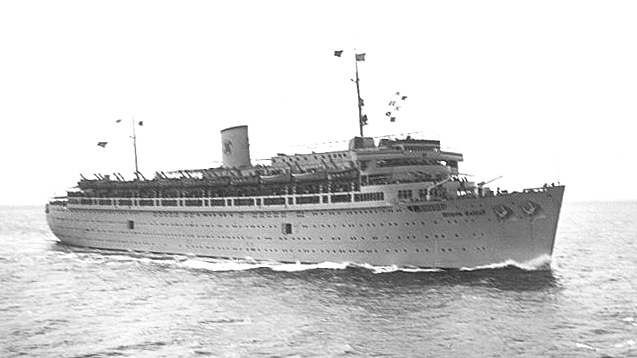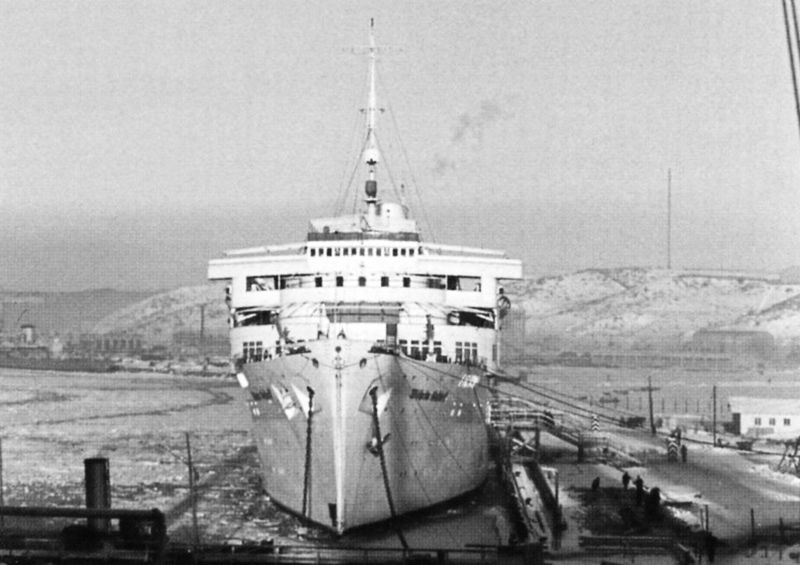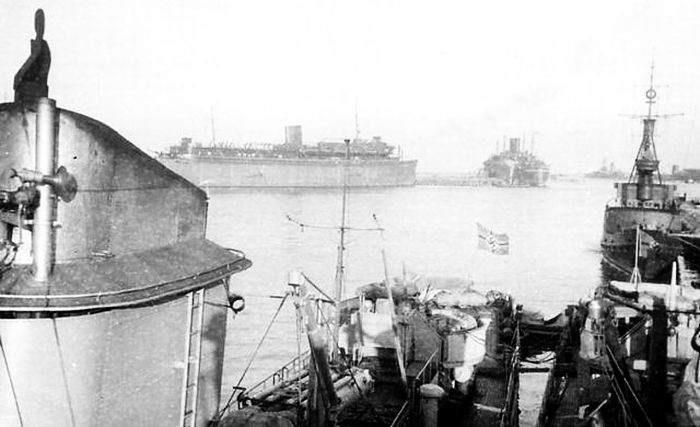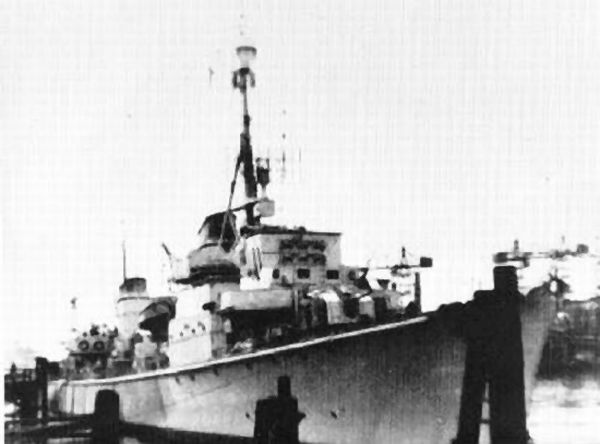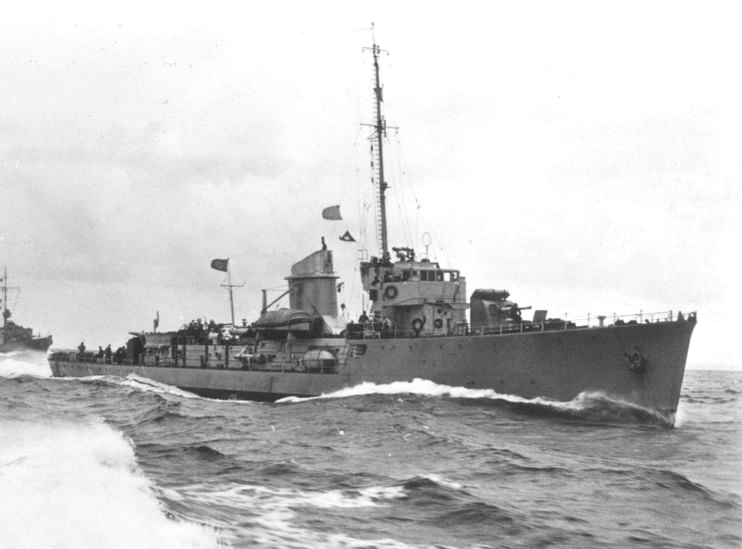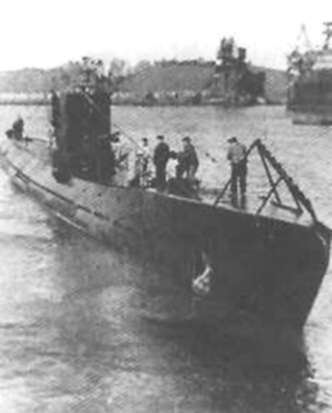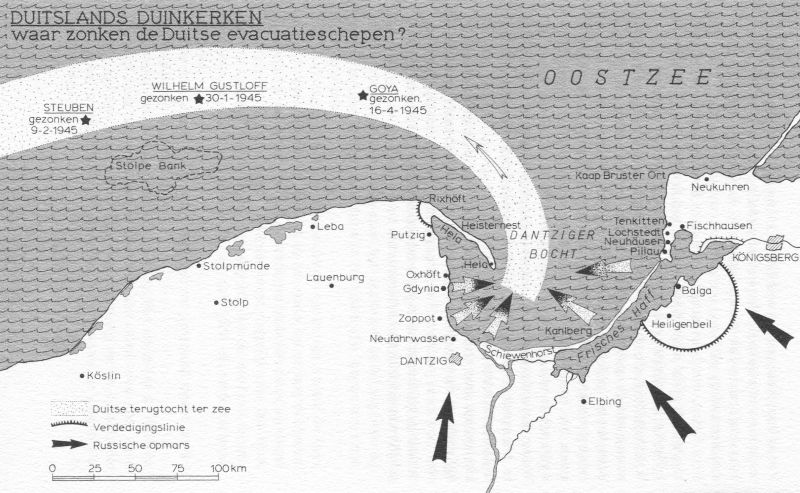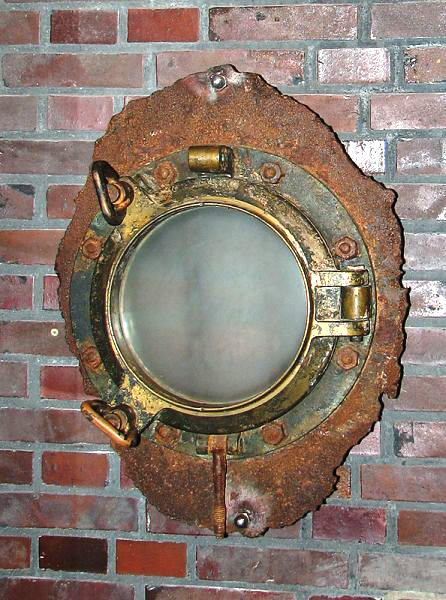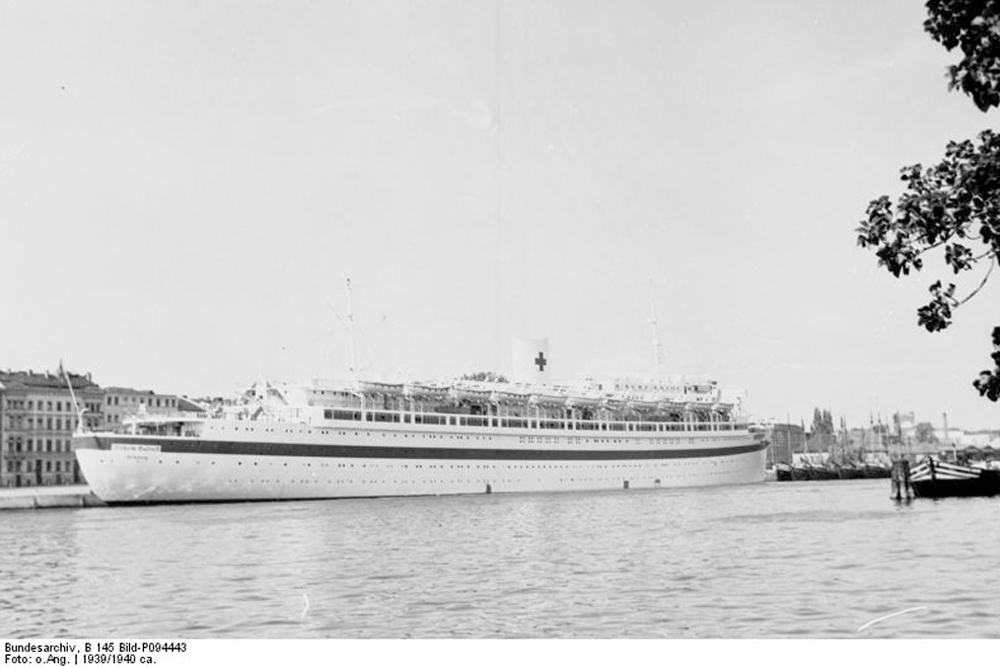Preface
May 5, 1937 was an important date for the Nazi Regime in Germany. On that day the new passenger liner and cruise ship Wilhelm Gustloff was launched on the Blom & Voss shipyard in Hamburg and named after the Gauleiter Wilhelm Gustloff, leader of the Swiss nazy party. On 4 February 1936 Gustloff was killed by the young Yugoslavian Jew David Frankfurter. Gustloff had been a fanatic and a militant follower of Hitler since the early days of the Nazi movement. In Switzerland it was his job to spread the Nazi doctrine under the German speaking Swiss and to gather information about the Germans who lived there and were anti Nazi. Wilhelm Gustloff was given his memorial on that fifth May in 1937 when his widow Hedwig baptized the ship in the company of Hitler and his most important henchmen.
Adolf Hitler himself gave the order to build the ship, which was to become the flagship of the movement Kraft durch Freude, (strength through pleasure, or KdF). This organization was part of the Deutsche Arbeitsfront (German Labour Front, or DAF), an organization founded by Hitler and managed by the Nazi regime that rewarded good work performance with outings and holidays.
From 1933 onwards, KdF provided affordable leisure activities such as concerts, theater performances and day outings. These labourers had to be party members of the National Socialist party (NSDAP). Some time later, KdF started with organizing cruises. In those days, cruises were only a prerogative for wealthy Americans, Britons and Frenchmen, who had access to excessive luxury on their transatlantic ocean liners. In these foreign ships, however, there was a keen distinction between first-, second- and third class cabins, symbolising the class distinction. The Wilhelm Gustloff, however, had identical accommodations for both the 400 crew members and the 1,465 passengers. In this way, the Nazi’s emphasized the absence of classes in the new Germany. The Nazi’s wanted to prove that in Hitler’s Germany the labourers were treated as ladies and gentlemen and not the rich. Or, as a German writer put it: "the Wilhelm Gustloff was not meant for the great and wealthy, but for the locksmith from Bayreuth, the postman from Cologne, the wardrobe lady from Bremen and the housewife from Karlsruhe".
Hitler and his henchmen were eager to use the baptism of the Wilhelm Gustloff, to promote the National Socialist ideology by delivering a great number of their well known speeches. The baptism of the new Nazi ship was enlivened by music bands, cheers of thousands of spectators and the bellowing ship’s horns when the ship slid down the slipway with increasing speed. Until September 1939, the ship met Hitler’s expectations excellently. The Wilhelm Gustloff brought many thousands of labourers to the Norwegian fjords, Portugal and Italy and thus spread the intended message of the Nazi’s. After only 50 cruises and 17 months of flag display the vessel was converted into a hospitalship in Hamburg. Already in 1940 the Wilhelm Gustloff sailed eastward to captured Gdynia, later on renamed Gotenhafen by Hitler to serve as accommodation for new submarine crews, who received their training there. More than four years the ship remained berthed in the occupied Polish harbour and she delivered a stream of German submarine crews that almost brought Great Britain to its knees.
Grossadmiral Karl Dönitz was particularly attracted to his U-boatmen and wanted to bring them to safety, early 1945, together with hundred of thousands of soldiers, wounded and other refugees. Under the Codename Hannibal, Dönitz organized an enormous evacuation operation and managed to keep over 2,000,000 German soldiers and civilians out of the hands of the advancing Red Army. The Wilhelm Gustloff was also deployed in operation Hannibal and apart from 1,000 soldiers of the Kriegsmarine, over 9,000 other refugees embarked on January 30, 1945, including many wounded soldiers, women and children.
The attempt to escape would end in disaster. In the evening of 30 January the Wilhelm Gustloff was hit by three torpedoes of the Soviet submarine S-13 under the command of Alexander Marinesco and sank a few moments later in the freezing cold water of the Baltic Sea. Many people on board went down with the ship and those who managed to leave the ship in time perished in the icy water. Of the people on board, only 1,250 were saved by German ships and over 9,000 refugees drowned. This linked the name Wilhelm Gustloff to the greatest maritime disaster in history at the time. This was not what Hitler had expected, who wanted the ship to be known as one of the symbols of the Third Reich.
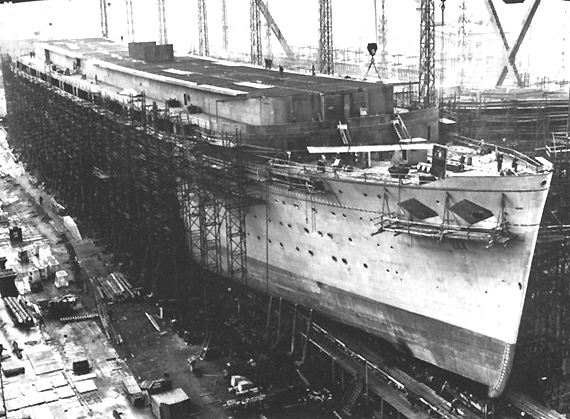
The Wilhelm Gustloff under construction at Blohm & Voss at Hamburg. Source: Courtesy of Michael W. Pocock
Definitielijst
- Gauleiter
- Leader and representative of the NSDAP of a Gau.
- ideology
- A collection of principles and ideas of a certain system.
- Kriegsmarine
- Germa navy. Part of the Wehrmacht next to Heer and Luftwaffe.
- Nazi
- Abbreviation of a national socialist.
- Red Army
- Army of the Soviet Union.
Cruise ship Wilhelm Gustloff
The keel of the Wilhelm Gustloff was laid August 1, 1936 at the yard of Blohn & Voss in Hamburg, construction number 511. It took the yard a mere 20 months to finish the construction of the 227 yards long and 26 yards wide ship and on March 15, 1938 it was completed. After a successful trial run on the North Sea under stormy conditions, the Jungfernfahrt (maiden voyage) of the 25,484 ton Wilhelm Gustloff was scheduled for March 24, 1938. To breed goodwill with the Austrians, whose country was soon to be annexed by Hitler, two thirds of the carefully selected passengers on the maiden voyage of the cruise ship were from the Alpine country, south of Germany. The passenger group consisted furthermore of 300 girls of the Bund Deutscher Mädel (League of German Girls or BDM) and 165 journalists. Commanded by Kapitän Carl Lübbe the Wilhelm Gustloff embarked on a three-day cruise on the North Sea which was afterwards considered a great success. The Austrians in particular were full of praise for this sailing symbol of German naval engineering and unity.
On March 29, 1939, Hitler paid an official visit to the Wilhelm Gustloff which he had not seen since the launch in 1937. This first visit of the Führer to the Nazi ship would also be his last. Three days later the new German vessel departed for a second cruise that would bring her to the Channel at Dover. This time the passengers were German labourers which brought this cruise within the framework of the targets of the KdF. Moreover, the Wilhelm Gustloff left the port of Hamburg in the company of the KdF-vessels Der Deutsche, Oceana and Sierra Cordoba. During the outward trip the four ships ran into a storm 25 nautical miles north of Terschelling. The four 8-cylinder MAN Diesel engines of the Wilhelm Gustloff, producing 9,500 HP had little trouble with the high waves and strong winds. The next morning, on April 2, 1938, around 07:45 hours, a motor launch of the Wilhelm Gustloff rescued 19 British sailors from the freighter Pegaway, which had run into trouble, owing to the storm. The British sailors enjoyed the rest of the cruise and were brought ashore in Hamburg on April 5. The rescue of the British was widely reported in the media and local and international newspapers reported the event extensively and praised the courage of the captain and crew of the German ship. This positive attention was of course highly favourable to the German Nazi regime.
To give the annexation of Austria, under the Anschluss a legal pretext, Hitler had German and Austrian voters cast their votes in April 1938 on the already decided subject. Kapitän Lübbe was ordered to steam up the Thames estuary, three miles outside the territorial waters of Great Britain. The German ship anchored there in order to serve as a floating polling station. On that day, nearly 2.000 German and Austrian citizens living in Great Britain cast their votes aboard the Gustloff after being transported from the Tilbury Docks, east of London. The German propaganda machine made good use of the opportunity when the British press praised the impressive German ship and the extravagant, but smooth course of the voting process.
On April 22, 1938 Kapitän Lübbe was found dead on the bridge of the Wilhelm Gustloff, He had died on the job of a heart attack. He was replaced for the duration of one cruise by Kapitän Friedrich Petersen, after which merchant navy captain Heinrich Bertram was assigned to assume command of the Wilhelm Gustloff.
From mid April 1938 until mid August 1939 the Wilhelm Gustloff was employed by KdF. During the warm summer months, trips were made to the Norwegian fjords. For political reasons, the passengers were not allowed to go ashore in the Scandinavian country. During the cold winter season, the Wilhelm Gustloff sailed, from time to time in the company of other KdF-vessels, to warmer regions such as Lisbon and Madeira and to the Mediteranean where ports as Tripoli in the present Libia and Napels en Genoa in Italy were visited.
The series of cruises of the Wilhelm Gustloff was interrupted in May 1939 when the ship, together with seven other ships of the KdF was ordered to repatriate German soldiers who had fought at the side of Generalissimo Francisco Franco during the Spanish civil war. On May 24, the German ships arrived in the Spanish port, Vigo to bring home the German volunteer soldiers of the famous Condor Legion home, now that the civil war in Spain had come to an end. This was the only time that the ship was deployed strictly as a trooptransport.
During the fiftieth cruise of the Wilhelm Gustloff, on August 25, 1939, Kapitän Bertram received a coded radio message, ordering him to open the secret letter, that was hidden in his cabin. He was ordered to return immediately to Hamburg, without any explanation given to him, his crew and the passengers. Nobody could have imagined that the days of cruise ship Wilhelm Gustloff were definitively over.
Definitielijst
- Condor Legion
- Name of German air force (mainly) units that fought alongside General Franco during the Spanish civil war from 1936-1939.
- Führer
- German word for leader. During his reign of power Adolf Hitler was Führer of Nazi Germany.
- mid
- Military intelligence service.
- Nazi
- Abbreviation of a national socialist.
- propaganda
- Often misleading information used to gain support among supporters or to gain support. Often used to accomplish ideas and political goals.
- Spanish civil war
- Fierce and cruel civil armed conflict in Spain from 1936 to 1939 between left (from anarchic to liberal) and right (church, nobility and army). In 1936 the fascist-oriented general Franco started military uprisings. With the help of Hitler and Mussolini he beat the republicans who vainly were supported by the International Brigade.
Hospital ship Wilhelm Gustloff
Most of the 417 crew members of the Wilhelm Gustloff were transferred on 2 September 1939. Only Kapitän Bertram and some of his most important officers stayed on board. The only thing Bertram and his men knew at that moment was that the Gustloff was going to be deployed in the war, Germany had started the day before by invading Poland. On September 22, the official announcement came that the Gustloff and the other cruise ships of the KdF-movement would be deployed als hospital ships. According to the rules of the The Hague Convention the Wilhelm Gustloff would be made recognisable by applying a green line along the length of the ship and Red Cross signs. The vessel was then placed with the Kriegsmarine as Lazarettshiff D. During the following weeks the ship was further adapted to her new role. Doctors, nurses and a new crew came aboard and 500 beds were prepared to accommodate the wounded.

Repatriëring van gewonde Duitse soldaten vanuit Noorwegen door hospitaalschip Wilhelm Gustloff. Source: Bundesarchiv
At the end of September 1939, Lazarettschiff D was sent to Gotenhafen where it served as a floating hospital until mid April 1940. Wounded Polish soldiers were taken in also and received proper treatment before they were taken prisoners of war. Halfway April the German hospital ship left for the North sea in support of the German campaign in Norway. On May 10, the ship docked in Oslo. The political reasons why the Wilhelm Gustloff was not allowed to dock in a Norwegian port before the war, became clear to everyone. After the capitulation of Norway, on June 10, 1940, Lazarettshiff D remained another three weeks in Oslo to fulfill her medical duties. In Norway some German wounded were taken care of, what made the previous care of the Polish soldiers appear more like a propaganda stunt than a humanitarian action. On June 2, the hospital ship left Norway and transferred 750 wounded German soldiers to Kiel and Swinemünde in northern Germany.
At the beginning of July, Hitler had announced his plans for the invasion of Britain to his henchmen and his chief military commanders. Lazarettschiff D, with many other hospital ships were assigned to take part in the Nazi’s grand plans. The Germans lacked specially trained amphibious troops and expected a greater number of casualties than in their previous campaigns. On September 5, 1940 Lazarettschiff D arrived in Wesermünde, Bremerhaven, after a short stay in Kiel for repairs on her degaussing system against magnetic mines. Hitler wanted to have supremacy in the air before the invasion of Britain began. The hospitalships were going to be stationed in Rotterdam during the amphibious landings. However, it would not come to that, for the British pilots fought like lions and the Luftwaffe lost the battle of Britain to the Royal Air Force (RAF). In mid September, Hitler called off the invasion of Britain and began to focus on an east front. This reduced the importance of a great many hospital ships. On October 22, the hospital schip Wilhelm Gustloff was sent to Oslo for the last time and she returned to Swinemünde with 414 wounded soldiers.
Definitielijst
- capitulation
- Agreement between fighting parties concerning the surrender of a country or an army.
- invasion
- Armed incursion.
- Kriegsmarine
- Germa navy. Part of the Wehrmacht next to Heer and Luftwaffe.
- Luftwaffe
- German air force.
- mid
- Military intelligence service.
- Nazi
- Abbreviation of a national socialist.
- propaganda
- Often misleading information used to gain support among supporters or to gain support. Often used to accomplish ideas and political goals.
- RAF
- Royal Air Force. British air force
Trainings ship Wilhelm Gustloff
On November 17, 1940 the Wilhelm Gustloff was sent again to the Gulf of Danzig where she arrived three days later. The former cruise- and hospital ship berthed at the Oxhöft Pier in Gotenhafen where the ship was converted as a hostel/lodging ship. The Gustloff could now be adapted to accommodate 1000 Kriegsmarine men who were trained on board, together with their instructors, to become U-boat crews. The medical equipment, doctors and nurses had already left and in Gotenhafen the crew was reduced to a skeleton crew who took charge of the ship’s maintenance and the diesel engines. Captain Bertram remained in command. The ship was completely repainted in navy grey. Camouflage was much more important as the Wilhelm Gustloff, now a training vessel was a legitimate military target.
The Wilhelm Gustloff would serve as a training ship for four years. From 1942 onwards, Korvettenkapitän Wilhelm Zahn was in charge of the training of the men who posed one of the greatest threats of the Allies during the Second World War, in particular the years ‘40, ‘41 and ‘42. From end 1943 however, more and more U-boats were lost since the Allies were able to defend their convoys better and better, thanks to the arrival of radar, better submarine detection- and combat materiel and the deployment of auxiliary carriers. That made Zahns recruits gradually younger and younger over the years, their training period shorter and their chance of survival smaller. Grossadmiral Karl Dönitz, commander of the Kriegsmarine, visited Gotenhafen and the Wilhelm Gustloff in March 1943. On October 9, of the same year Gotenhafen was targeted by bombers of the American 8th Air Force. For the first time in the history of the Wilhelm Gustloff, the ship was under threat of a direct attack. The former KdF ship narrowly escaped severe damage when an Allied bomb exploded on the starboard side of the ship. The blow only caused a tear in the ships hull, which could be repaired without problems. Other ships were less lucky. The former KdF ship Stuttgart and some other German vessels were sunk.
All those years, the engineers of the ship did their utmost with less available means, to keep the main engines and auxiliary diesel engines running. On the one hand, this was necessary for the energy supply on board of the training ship Wilhelm Gustloff and on the other to keep the ship ready to sail. On 20 February 1944 Captain Friedrich Petersen returned as captain of the former KdF vessel. He replaced captain Bertram, who had applied for a command on a ship that was still in active service. Petersen had been a POW and was released because the British assumed that at the age of 66 he could not be of use any longer for the German war machine. In spite of the fact that he had to sign a declaration that he would no longer be active as a ship’s captain, he was given the command of the, on paper, immobile Wilhelm Gustloff.
At the end of 1944, the military might of the Nazi regime began to crumble considerably. The German propaganda machine had great difficulty in reporting any success at all. Less and less U-boats returned to their bases, the Western Allies took hold in Normandy and advanced further in France and it had been months ago since the Germans had evacuated North Africa. Moreover, ally Italy had defected to the enemy. The greatest problem for the Germans, however, was the Soviet troops who advanced steadily in East Prussia, now a part of Poland. In October 1944, a section of the Red Army under the command of General Kuzma N. Galitsky had succeeded in crossing the border of the Greater German Reich and captured the town of Nemmersdorf. Incited by their political leaders, by orders of Stalin, the Soviet troops spared nobody. Women of all ages were raped, mutilated or killed. Children and the elderly were not spared either. This and other news of atrocities committed by the Soviets caused a huge flow of German refugees in western direction and the ports around the Gulf of Danzig.
Grossadmiral Karl Dönitz realized that the Germans in East Prussia would be defeated by the Soviets, but Hitler would not budge. However, at the urging of the Supreme Commander of the Kriegsmarine, the Führer gave permission to withdraw the U-boats westward. On 21 January 1945, Dönitz released the code signal Hannibal, which implied that his U-boats were allowed to retreat. The Commander of the Kriegsmarine, took advantage of operation Hannibal to evacuate as many German military personnel and citizens from the ports around the Gulf of Danzig under the pretext of the evacuation of the U-boat cadets and their training facilities. To this end he directed training ships like the Hansa and the Hamburg and passenger ships like the Deutschland and the Cap Arcona together with many freighters to the Gulf of Danzig. All these vessels were placed under the direct command of Dönitz himself, so that the evacuation was given the highest priority.
Definitielijst
- Führer
- German word for leader. During his reign of power Adolf Hitler was Führer of Nazi Germany.
- Kriegsmarine
- Germa navy. Part of the Wehrmacht next to Heer and Luftwaffe.
- Nazi
- Abbreviation of a national socialist.
- POW
- Prisoner of War.
- propaganda
- Often misleading information used to gain support among supporters or to gain support. Often used to accomplish ideas and political goals.
- radar
- English abbreviation meaning: Radio Detection And Ranging. System to detect the presence, distance, speed and direction of an object, such as ships and airplanes, using electromagnetic waves.
- Red Army
- Army of the Soviet Union.
- U-boat
- The German name for a submarine. German U-Boats (Submarines) played a very important role during the course of warfare until May 1943. Many cargo and passenger ships were torpedoed and sunk by these assassins of the sea.
Evacuation ship Wilhelm Gustloff
On January 22, 1945 Captain Petersen and Korvettenkapitän Wilhelm Zahn started preparations for the Wilhelm Gustloff, to set sail with as many submarine personnel, wounded German soldiers and civilian refugees as possible. The crew was supplemented with as many personnel of the Kriegsmarine as possible, which was of course not massively available any longer. Although the four main diesel engines had made only short test runs, the engineers managed to operate the machines reasonably well. The maximum speed of 15,5 knots, however, could not be reached any longer, according to the main engine room. A few lifeboats were hastily hoisted aboard. They had to replace the original ones who were requisitioned in recent years by the port authority to produce smoke screens during air raids. Several hundreds of rubber life rafts were also lashed to the sun decks. Under the watchful eye of Korvettenkapitän Wilhelm Zahn anti-aircraft guns were installed on board and deployed.
Six days later, the Wilhelm Gustloff was ordered to prepare to sail within 48 hours. In the meantime, the city of Gotenhafen was flooded with refugees. Nearly all of them women and children, since the SS men took all available men out of the groups of refugees to fight against the advancing Soviets.
In spite of the chaos in the harbour, the boarding of the Wilhelm Gustloff occurred relatively disciplined at first. Armed guards made sure that only those with the highest priority were allowed a place on board. This was the submarine crews, crew members and several hundreds members of the Navy Women’s Division. Influential or wealthy refugees also were more likely to receive a boarding pass. The much sought-after tickets were printed on the Wilhelm Gustloff itself, in the printing shop, where in better days the colourful cruise programs and menu’s were produced. As the time of departure approached, the control on the boarding flagged and the counting was lost sight of. Officially, on the morning of January 30, 918 Navy personnel, 173 crew members, 373 members of the Navy Women’s Division, 162 wounded and 4,424 refugees were on board of the Wilhelm Gustloff. At this moment, however, a great many more refugees had boarded the Wilhelm Gustloff, illegally, smuggled on board or secretly admitted by corrupt guards.
At last, around 13:00 on January 30, 1945 the evacuation ship Wilhelm Gustloff came loose of its moorings and four tugboats started to tow the ship out of the harbour. Immediately the large ship was stopped by dozens of little boats, full of desperate refugees. Women held their children in the air and begged to be admitted aboard. Crew members of the Wilhelm Gustloff let down rope ladders, climbing nets and gangways and thousands of refugees were rewarded for their perseverance and climbed on board. When the Wilhelm Gustloff eventually left the harbour on that icy cold and gray day at the end of January 1945 nobody knew exactly how many people were on board. Rudi Lange, a 21 year old quartermaster and radio operator who came to reinforce Wilhelm Gustloffs crew at the last moment, reported on a reunion of survivors: "we lowered the nets and everyone from the boats scrambled up as best they could. I seem to recall that when we were underway, one of the officers told me to send a message that we had another 2000 persons added to the number of passengers".
Definitielijst
- Kriegsmarine
- Germa navy. Part of the Wehrmacht next to Heer and Luftwaffe.
Calamity ship Wilhelm Gustloff
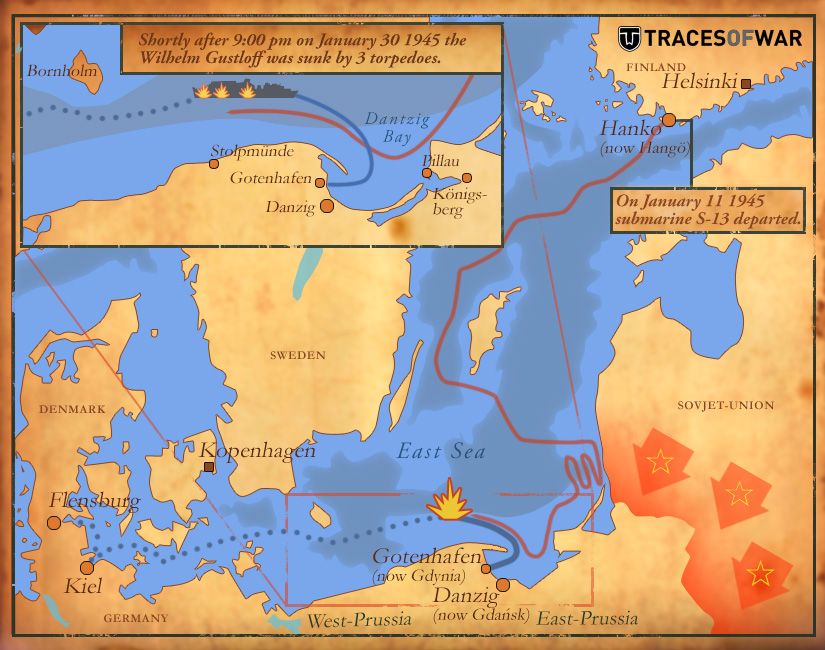
Geographical survey of the disaster with the Wilhelm Gustloff. Source: Source: Roger Paulissen, Go2War2.nl.
Although the Wilhelm Gustloff was designed to facilitate 1,465 and 400 crew, on January 30, that number was multiplied fivefold at least. About half of the persons on board were children. Icebreakers were needed to clear a sailing route for the former cruise ship. It was 18 degrees below zero when the ship left Gotenhafen behind around 13:00 PM. On the bridge an argument arose immediately between captain Petersen and Korvettenkapitän Zahn, about the course the Wilhelm Gustloff was to follow. Zahn preferred the western route through shallow water and with maximum speed taking the shortest route. In theory, he was right, for a fast liner could, even without an escort dodge the much slower enemy submarines. Captain Petersen, however, pressed down on him that the Wilhelm Gustloff was not a fast ship at all and even in her best years could make no more than 15 knots. Apart from that, the ship suffered some bomb damage and the propeller shaft tunnel was never repaired satisfactorily. Therefore, captain Petersen chose for the northern route which further on moved west, so that the ship would pass above the Stolpe Bank. According to him, this was the safest route, free from mines and shallows.
The Wilhelm Gustloff had been given two small warships as an escort, the Löwe and the TF 19. The Löwe was a Steipner-class torpedoboat of 735 tonnes captured from the Norwegians on April 9, 1940. They had commissioned the ship in 1938 as Gyller. The second escort was Torpedofangboot 19, up to that moment only used to pick up training torpedoes. The TF 19 however, got into trouble with a leaky weld seam in the choppy Baltic Sea and had to return to Gotenhafen. With the Löwe as only escort, the Wilhelm Gustloff carried on. At around 8:00 PM, a signal was received that a group of German minesweepers approached on a counter course with high speed. To avoid collision, the Wilhelm Gustloff had the navigation lights switched on. In this dangerous situation the Wilhelm Gustloff’s crew comforted itself with the knowledge that the heavy cruiser Admiral Hipper and her escort the new Flottentorpedoboot T 36 of over 1.500 tonnes, would pass her around midnight on a parallel course. The presence of these large warships in the neighbourhood of the fleeing Gustloff had also been a reason for the Kriegsmarine to let the ship leave with its small escort.
In spite of the fact that the submarine tracking equipment aboard the Löwe was rendered inoperable by frost, the anti-aircraft guns on board of the Gustloff unusable due to icing and the rigging to launch the lifeboats frozen, there was some relaxation on the bridge of the fleeing ship around 20:30 hrs. The commanders thought to have completed the most dangerous part of the voyage and had just eaten and enjoyed a glass of brandy. At that moment, the Löwe and Wilhelm Gustloff were dependent on the observations of their lookouts who had an exceptionally difficult job to do.
Meanwhile, the Soviet submarine S-13, under the command of Kapitan III Ranga Alexander I. Marinesco, active on the Polish-German coast. Shortly after the Wilhelm Gustloff had switched on her navigation lights, she was noticed by a lookout and the commander of the S-13. In a conversation, recorded in the official history of the Baltic Fleet, Marinesco narrated: "when the snow suddenly cleared I saw the silhouette of a large ocean vessel, it was great, it even ran some lights. At that very moment I estimated that it must be around 20.000 tonnes, no less. I was sure that it was full of men who had trampled Mother Russia and were now trying to save their lives. I decided that it had to be sunk and the S-13 was going to do it. Only the question mattered where and when. I was mentally prepared for a surface attack for better accuracy with a bow salvo. Then, it occurred to me that I had to pass around the back of the convoy to attack from the shore side. From that direction they would not expect an attack. Their lookout would be chiefly directed to the sea. The only thing we had to do was to make our calculations correctly and stay cool. We could bother about the minesweeper later on".
With the minesweeper, Marinesco meant the Löwe and maneuvered his submarine between the shore and the Wilhelm Gustloff and followed the large German vessel to reach the correct firing position. Shortly after 21:00 hours, ignorant of the thousands of refugees on board of the enemy vessel, he ordered to launch all four of the torpedoes of the bow tubes on the Wilhelm Gustloff. At 21:16 the first torpedo of the S-13 hit its target. The underwater projectile caused an explosion and a gaping hole in the port bow of the German ship. Moments later, the second torpedo hit the Wilhelm Gustloff amidships, near the empty swimming pool, that was used to accommodate the navy women. The third torpedo hit the ship’s engine room, near the funnel. The fourth torpedo jammed in the tube, what brought the crew in great danger. While the torpedo makers worked feverishly to defuse the jammed torpedo, Commander Marinesco watched from the conning tower how the Wilhelm Gustloff listed heavily over the port and began to sink.
In order to prevent the bow of the Gustloff from making too much water through the hole in the bow, the order was immediately given to close the front watertight bulkheads. That caused the quarters of the off-duty crew members to be closed off, resulting in eliminating precisely those men with the knowledge how to lower the lifeboats and other emergency procedures. The second torpedo caused immediate, fatal consequences for many passengers, but the third hit sealed the fate of the calamityship Wilhelm Gustloff. The direct hit in the engine room caused all engines and power supplies to stop. In the dark and listing vessel a terrible panic ensued that caused a chaos as the terrified refugees left the ship. Many were trampled, crushed or seriously wounded in the overcrowded corridors of the ship. Those who were able to reach the decks learned soon that it was barely possible to lower the lifeboats. During attempts to jettison life rafts, many refugees slipped on the ice covered, slippery decks and disappeared in the icy waters of the Baltic without a chance. Those who jumped overboard in panic shared the same fate.
To send out an SOS, radio operator Rudi Lange’s only possibility was an emergency transmitter, with a range of barely 2,000 meters. This signal was, however, immediately noticed by the Löwe who turned around right away and sent the signal through. Whilst the torpedoboat picked up the first castaways, the human drama increased. ‘Women and children first’ and ‘the captain goes down with his ship’ were not on, for the male crew members paved their way to the lifeboats and captain Petersen was the first to seek the relative safety of a lifeboat. Other men made an end to the miserable situation and the lives of their families and themselves with pistol shots. In spite of this, some lifeboats were lowered after all and were filled in no time with benumbed drowning people. Those who still tried to clamber aboard were literally beaten off. Seventy minutes after Wilhelm Gustloff was hit by the first torpedo, she slowly disappeared in the choppy and icy waves of the Baltic Sea. Thousands of people still on board went down with the ship and perished.
Just before Wilhelm Gustloff went down, the torpedoboat T 36 arrived which, just as Löwe, picked up as many people out of the icy water as possible. The heavy cruiser Admiral Hipper, who herself had more than 1.300 refugees on board, was ordered to sail on. The submarine threat was too big and the Kriegsmarine considered the warship too precious to loose while rescuing drowning people. Three minesweepers who arrived on the scene later on were able to rescue a few dozen of people, but the freighters Göttingen and Gotenland could almost only recover frozen bodies. Seven hours after Wilhelm Gustloff had sunk, the crew of the Vorpostenboot (patrol craft) VP 1703 saved a baby out of a lifeboat of the former KdF ship. This lucky infant was the last official survivor of the Wilhelm Gustloff who was brought into safety.
Definitielijst
- cruiser
- A fast warship with 8,000 – 15,000 ton displacement, capable to perform multiple tasks such as reconnaissance, anti-aircraft defence and convoy protection.
- Kriegsmarine
- Germa navy. Part of the Wehrmacht next to Heer and Luftwaffe.
- torpedo
- A weapon of war. A cigar shaped body fitted with explosives and a propulsion and control mechanism. Intended to target after launch a nearby enemy ship and disable it by underwater explosion.
Epilogue
Since the calamitous sinking of the Since the calamitous sinking of the Wilhelm Gustloff, many estimates have been made about the exact number of people on board the disaster vessel. A research team of Discovery Channel’s "Unsolved History" has proven that the number of people on board the Wilhelm Gustloff was over 10.000. The team arrived at this conclusion by means of computer calculations of the number of victims. A fixed fact was that the Löwe rescued 472 shipwrecked, the T-36 564, the three minesweepers in total 179, the other vessels 37 and the VP 1703 1. This brought the total of survivors to 1.253. The computers used the software program ‘Maritime Exodus’ and calculated the circumstances in which the Wilhelm Gustloff sank, comparing it with the time it took for the ship to go down. This means that 85 to 90 percent of the people on board could not have survived the disaster, which confirms the large number of persons on board.
The Nazi regime did not pay much attention to the sinking of the Wilhelm Gustloff, since in those days there was already too much bad news to report. The news of the sinking of one of the most eminent of Nazi symbols by the Soviets had better be avoided. On February 9, 1945, the German passenger liner Steuben, packed with German refugees was sunk, also by Marinesco’s S-13, on the same route as the one Wilhelm Gustloff took. This time with over 4.000 victims. On the 6th of April of the same year, Soviet torpedoes, again on the route of the Wilhelm Gustloff, sank the German freighter Goya, also a refugee vessel, crowded with refugees who tried to escape the wrath of the Soviet troops. This disaster caused 6,600 victims.
Even though these disasters, that can individually be counted among the greatest maritime disasters in history, were enormous, they did not mean much in the context of Operation Hannibal. Grossadmiral Karl Dönitz himself stated in his memoirs: "between January 23, and May 8, 2,022,602 persons from Kurland, Eastern- and Western Prussia and later on from Pomerania and parts of Mecklenburg, were safely transported to the west by sea. The evacuations were carried out under continuous attacks by British, American and Russian aircraft, by Russian submarines and light coastal forces and by way of sea routes in which large numbers of mines were repeatedly laid. The losses suffered were truly huge: 4.000 persons perished on the Wilhelm Gustloff, 7.000 with the loss of the Goya and 3.000 with the hospitalship Steuben. How terrible though these losses were, they represent only one percent of the total of persons, transported by sea; 99 percent reached the ports in the western Baltic safely". In his opinion, Operation Hannibal was a great success. The large number of relatives of the victims will not be satisfied with these relativistic statistics, also underestimated by Dönitz, as far as the Wilhelm Gustloff is concerned. They still lack the recognition and commemoration of the incredible disasters that went along with the collapse of Hitlers Nazi regime.
Alexander Marinesco also fought unsuccessfully for recognition by the Soviet government after his successful attacks on Wilhelm Gustloff and Steuben. Before his successes he had already fallen into disgrace with Stalin and his henchmen due to his way of life. He was a notorious drunk and womanizer who was often absent when sleeping off his intoxication. This became almost fatal for him when he was missing in Turku, Finland. His absence took such a long time that he was accused of desertion. Only the fact that he was an outstanding submarine commander, and enjoyed some protection of his direct superiors, who knew that the crew of the S-13 would not sail without Marinesco, saved him. After the war his victories were not acknowledged and because he made so many enemies in his struggle for this acknowledgement he became a victim of the purges within the navy, launched shortly after the war. He disappeared in a prison camp in Siberia after a phony accusation of theft. By then, he was no longer in the service of the Soviet Navy. He survived the camps, but died of cancer in 1963 in Leningrad. In 1990 he was honoured posthumously as Hero of the Soviet-Union and given a monument in Kaliningrad, the former Königsberg in East-Prussia. In addition, the submarine museum in St. Petersburg was named after him.
Definitielijst
- Nazi
- Abbreviation of a national socialist.
Information
- Article by:
- Peter Kimenai
- Translated by:
- Cor Korpel
- Published on:
- 30-01-2021
- Last edit on:
- 08-03-2021
- Feedback?
- Send it!
Related sights
Related books
Sources
- DOBSON, C. e.a., De ondergang van de Wilhelm Gustloff, Elsevier, Amsterdam/Brussel, 1979.
- HUMBLE, R., Duitse Kriegsmarine, Standaard Uitgeverij, Antwerpen, 1991.
- MALLMANN-SHOWELL J.P., Das buch der deutschen kriegsmarine 1935-1945, Motorbuch verlag, Stuttgart, 1995.
- POOLMAN, K., Allied Submarines of World War Two, Arms & Armour Press, London, 1990.
